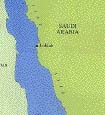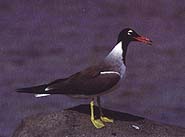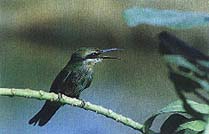BIRDS OF
WESTERN SAUDI ARABIA (Part One)
Text and pictures by Dr. Graham R. Lobley
CLICK ON THE MAP FOR ENLARGEMENT (41k JPEG)
 The
outstanding natural beauty of the landscape of western Saudi Arabia is
fully complemented by its varied wildlife. In particular, the region has
an impressive variety of bird species, augmented significantly by the twice-yearly
migrations of many birds between Africa and their Eurasian breeding areas.
This two-part article presents an account of the bird watching year in
the west and southwest of the country and describes the principal habitats,
both natural and man-made, from the Red Sea eastwards into the Sarawat
mountains. Accessible bird watching sites are mentioned, which are typical
of the varied habitats of this fascinating region.
The
outstanding natural beauty of the landscape of western Saudi Arabia is
fully complemented by its varied wildlife. In particular, the region has
an impressive variety of bird species, augmented significantly by the twice-yearly
migrations of many birds between Africa and their Eurasian breeding areas.
This two-part article presents an account of the bird watching year in
the west and southwest of the country and describes the principal habitats,
both natural and man-made, from the Red Sea eastwards into the Sarawat
mountains. Accessible bird watching sites are mentioned, which are typical
of the varied habitats of this fascinating region. The
Hijaz and Asir provinces of western and south-western Saudi Arabia are
exciting places to bird, lying at the Palaearctic and Afrotropical faunal
boundary. The biodiversity of the region is considerably enhanced by the
high coastal Sarawat mountain range, which runs parallel to the Red Sea.
Jebel Souda in Asir is the highest point in the Kingdom, at 3050m. Rainfall
is considerable in these mountains (200-600mm/yr.), especially along the
scenically dramatic west-facing escarpment rim zone, which supports a band
of Juniper forest up to 3 km. width in Asir. These woodlands hold a wealth
of special birds including Yemen linnet, brown woodland warbler, Yemen
warbler, Yemen thrush and dusky turtle dove. Nine of the ten species endemic
to the Arabian peninsula are found in the Asir mountains. Only the Arabian
accentor is restricted entirely to the Yemen. Additionally, two endemic
subspecies, the south arabian wheatear and the Asir magpie are restricted
to these mountains, the latter entirely to the Asir province.
The
Hijaz and Asir provinces of western and south-western Saudi Arabia are
exciting places to bird, lying at the Palaearctic and Afrotropical faunal
boundary. The biodiversity of the region is considerably enhanced by the
high coastal Sarawat mountain range, which runs parallel to the Red Sea.
Jebel Souda in Asir is the highest point in the Kingdom, at 3050m. Rainfall
is considerable in these mountains (200-600mm/yr.), especially along the
scenically dramatic west-facing escarpment rim zone, which supports a band
of Juniper forest up to 3 km. width in Asir. These woodlands hold a wealth
of special birds including Yemen linnet, brown woodland warbler, Yemen
warbler, Yemen thrush and dusky turtle dove. Nine of the ten species endemic
to the Arabian peninsula are found in the Asir mountains. Only the Arabian
accentor is restricted entirely to the Yemen. Additionally, two endemic
subspecies, the south arabian wheatear and the Asir magpie are restricted
to these mountains, the latter entirely to the Asir province.
Migration time is especially fruitful in March/April and September/October. The western coastal Tihama corridor constitutes a major migration flyway, funneling birds to and from Africa. Soaring birds, such as raptors (birds of prey) and storks, make the narrow southern Red Sea crossing at the straits of Bab el Mandeb, between Yemen and Djibouti. Thousands of steppe eagles make the crossing to over winter on the African savanna, returning via the same route the following spring to breed on the steppes of Asia.
The Tihama is a dry sandy plain, with stunted acacias and milkweed, so the smaller migrants concentrate at dry wadis which have more natural cover. Many pass directly through Jeddah. With the benefits of desalination, this modern city has been transformed into a well-watered garden and park land habitat, attractive to many migrant passerines (perching birds), notably shrikes and bee-eaters.
The impressive oil wealth of the Kingdom has produced one of the world's
most rapid economic transformations, one result being an excellent surfaced
road infrastructure, enabling ready access to all the typical habitats.
Although 4-wheel drive is preferred, much birding and photography can be
accomplished with an ordinary saloon car. There are several spectacular
escarpment ascents into the mountains via surfaced roads - to Taif, Baha
and Abha - each are feats of modern civil engineering. From these ascents
it is easy to see tristram's grackle and flocks of fan-tailed ravens.
CLICK ON DIAGRAM FOR ENLARGEMENT
(38k JPEG)
 Red
Sea coast and Jeddah
Red
Sea coast and Jeddah
A typical topographic section from the west coast eastwards
into the mountains starts at the Red Sea. The coral reef is one of the
world's richest ecosystems, and the birds of the shore are correspondingly
varied. Terns are abundant - including Saunder's little, white-cheeked,
gull-billed, swift, lesser-crested and caspian. Interesting gulls include
sooty, white-eyed and slender-billed, the latter occurring in large flocks
in the winter months. Other birds seen here include western reef heron,
spoonbill, greater flamingo and pink-backed pelican with an occasional
brown booby fishing inshore. One of the most interesting waders is the
crabplover - which is fairly easily seen just south of Jeddah, towards
Shoiba, especially during the winter months.
Jeddah and its environs attract an impressive number of passage migrants, winter visitors and breeding birds. Common residents include Ruppell's weaver, Nile valley sunbird, African and Indian silverbills, black bush robin, along with abundant ring-necked parakeet, common mynah, house crow and yellow-vented bulbul. The bulbul's pleasant call is a characteristic feature of the dawn chorus of Jeddah's birds. The black-winged stilt is an opportunistic breeder on seasonal lakes and the spur-winged plover is another likely breeder. Good numbers of glossy ibis spend the winter here and waste ground and park land hold namaqua and palm dove together with wintering isabelline shrike. Five other shrikes are passage migrants. Both the bee-eater and blue-cheeked bee-eaters are common migrants whilst the little green bee-eater is a resident. Other impressive migrants include waders such as the caspian plover and terek sandpiper.
In summer, the handsome white-eyed gull can be easily seen from Jeddah's
North Corniche, when both white-cheeked and caspian terns can also be found.
The gull is a Red Sea speciality as its breeding range is virtually restricted
to the Red Sea, from which it extends just south into the Gulf of Aden
and north into the  Gulfs
of Suez and Aqaba.
Gulfs
of Suez and Aqaba.
Spring migration is less spectacular than autumn, with a slightly different species mix. Wheatear and black-eared wheatear pass in early March with numerous small flocks of yellow wagtails of mainly the eastern beema form. Red-throated pipits are very evident in March and April, and there is a stronger bee-eater passage in spring compared to autumn. Common migrant waders include wood and green sandpiper.
Autumn migration is well underway by mid-late August with the arrival of the first red-backed shrike, golden oriole and roller. The peak passage for smaller passerines is September, which includes a small number of rufous bush robin, bluethroat, upcher's warbler and lesser grey shrike. Good numbers of woodchat and masked shrikes are observed and red-backed shrike is much the commonest shrike, with up to 20 present in suitable locations in Jeddah in mid-September. Flocks of 25+ blue-cheeked bee-eater pass through later, into early November, by which time up to six heron species can be observed inland - squacco, night, grey, purple herons and both little and cattle egrets.
Gorgeous blue-cheeked bee-eaters, hoopoe and up to six shrike species considerably enhance bird watching at migration times. One may also be lucky enough to see flocks of migrating demoiselle cranes. These birds pass directly over Jeddah in late March, often in flocks approaching 100 birds. The exhilarating sight and trumpeting calls of a flock of these inreasingly rare birds passing directly over the city is undoubtedly the highlight of the bird watching year in Jeddah. The return migration in autumn is not so well documented; some observations suggest that the cranes return in smaller family parties using the wadis along the eastern edge of the Tihama. These beautiful cranes spend the winter months on the opposite side of the Red Sea, from northern Ethiopia and into Sudan.
Nubian and Egyptian nightjars both occur in Jeddah during the winter months (September-March) - the Nubian is first (September-December) and the Egyptian follows (January- March). The nightjars have been recorded at the eastern edge of the city, within and near the US Geological Survey compound.
Attractive mangrove-fringed saline lagoons at Shoiba, 140 km. south of Jeddah, have breeding white-cheeked terns on coral islets in July/August and the sooty falcon is a possible visitor to this area in summer. The pallid harrier is the premium raptor migrant along the coast and across the Tihama, with a strong passage in March and a return passage extending into November. Kingfishers are quite common in winter.
The magnificent osprey is a fairly common resident all along the Red Sea coast. Ospreys often use lamposts along beach roads as favourite perches and feeding places, where they can sometimes be seen eating fish. The Farasan islands, in the southern Red Sea, support one the highest breeding densities of this species in the world.
There are several important areas along the Red Sea where mangroves occur, especially in the Asir Tihama between Amq and Al Qamah. Amq is about 5 hours drive south of Jeddah, on the main coast road to Jizan. These latter mangroves form an extensive woodland belt along the shore. The mangroves extend for tens of kilometres and form an important ecosystem.
Mangroves provide safe feeding, nesting and roosting places for many bird species. Both herons and spoonbills nest within these maritime thickets. In addition, mangroves in the Asir Tihama form an especially important wintering area for many northern wading birds, such as terek sandpiper, redshank and whimbrel. Resident birds such as the fascinating crab plover are also quite common here. Outside the breeding season, this species ranges south, as far along the east African coast as Kenya and Tanzania, although it is decidedly more local and difficult to see on the Kenya coast.
An islolated population of white-collared kingfishers was recently discovered in the Asir mangrove belt by Arthur Stagg. The birds were located north of Al Birk. This attractive kingfisher reportedly has a diet consisting entirely of small crabs, which are abundant in the area. Within the Arabian peninsula, the species also occurs in the United Arab Emirates, at another mangrove site at Khawr Kalba on the Gulf of Oman.
Contents
| News
| E-Mail
| Book
Reviews |
Home |
Back Issues
Web Links |
Forum |
Subjects |
Search |
Current Issue
| Subscribe
Arabian Wildlife. Volume 2, Number 1